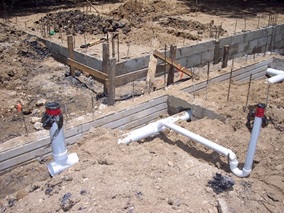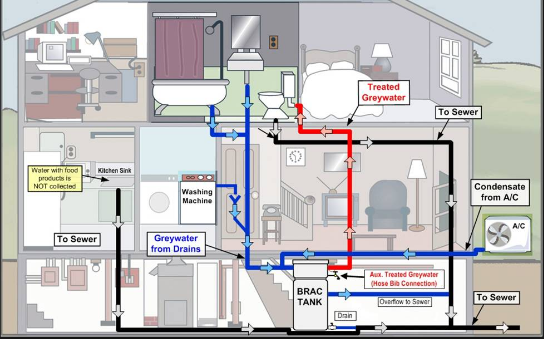The Design of Your Home's Plumbing System Explained
The Design of Your Home's Plumbing System Explained
Blog Article
What are your opinions on Plumbing Installation 101: All You Need to Know?

Recognizing how your home's pipes system functions is necessary for every single home owner. From delivering clean water for alcohol consumption, food preparation, and showering to safely eliminating wastewater, a properly maintained pipes system is essential for your family members's health and wellness and convenience. In this detailed guide, we'll explore the intricate network that comprises your home's pipes and offer ideas on maintenance, upgrades, and dealing with common issues.
Intro
Your home's plumbing system is more than simply a network of pipelines; it's a complex system that ensures you have accessibility to tidy water and effective wastewater elimination. Understanding its components and just how they collaborate can assist you protect against costly fixings and make certain whatever runs smoothly.
Fundamental Elements of a Pipes System
Pipelines and Tubes
At the heart of your plumbing system are the pipes and tubes that lug water throughout your home. These can be made from numerous products such as copper, PVC, or PEX, each with its advantages in terms of longevity and cost-effectiveness.
Fixtures: Sinks, Toilets, Showers, etc.
Fixtures like sinks, bathrooms, showers, and bathtubs are where water is utilized in your house. Recognizing just how these components attach to the plumbing system aids in identifying issues and planning upgrades.
Shutoffs and Shut-off Points
Valves manage the flow of water in your pipes system. Shut-off shutoffs are essential during emergencies or when you require to make repair services, permitting you to separate parts of the system without interfering with water circulation to the whole home.
Water Supply System
Main Water Line
The primary water line links your home to the community supply of water or a personal well. It's where water enters your home and is dispersed to numerous fixtures.
Water Meter and Pressure Regulator
The water meter measures your water usage, while a stress regulatory authority makes sure that water moves at a risk-free stress throughout your home's plumbing system, avoiding damage to pipelines and fixtures.
Cold Water vs. Hot Water Lines
Understanding the difference in between cold water lines, which supply water directly from the main, and warm water lines, which carry warmed water from the hot water heater, assists in repairing and planning for upgrades.
Drainage System
Drain Pipes Piping and Traps
Drain pipes carry wastewater far from sinks, showers, and toilets to the sewer or septic system. Traps prevent sewage system gases from entering your home and also catch debris that might create blockages.
Ventilation Pipes
Air flow pipes allow air right into the water drainage system, avoiding suction that could slow down water drainage and trigger catches to empty. Proper air flow is vital for maintaining the stability of your plumbing system.
Relevance of Appropriate Water Drainage
Making sure appropriate water drainage avoids back-ups and water damages. Consistently cleaning up drains pipes and maintaining catches can prevent pricey repairs and prolong the life of your pipes system.
Water Heater
Types of Water Heaters
Hot water heater can be tankless or traditional tank-style. Tankless heating units warmth water on demand, while tanks keep warmed water for immediate use.
Updating Your Plumbing System
Reasons for Upgrading
Updating to water-efficient components or changing old pipelines can enhance water quality, minimize water costs, and increase the value of your home.
Modern Pipes Technologies and Their Advantages
Discover innovations like clever leakage detectors, water-saving bathrooms, and energy-efficient hot water heater that can save money and decrease ecological influence.
Expense Considerations and ROI
Determine the ahead of time costs versus long-term cost savings when considering plumbing upgrades. Numerous upgrades pay for themselves with minimized energy bills and less repairs.
How Water Heaters Link to the Plumbing System
Understanding how hot water heater connect to both the cold water supply and hot water distribution lines helps in diagnosing problems like inadequate hot water or leaks.
Maintenance Tips for Water Heaters
On a regular basis purging your water heater to eliminate sediment, checking the temperature level settings, and examining for leakages can expand its life expectancy and improve power efficiency.
Common Pipes Issues
Leaks and Their Causes
Leaks can happen because of aging pipelines, loosened fittings, or high water stress. Attending to leakages quickly avoids water damage and mold and mildew growth.
Clogs and Clogs
Blockages in drains and commodes are commonly caused by flushing non-flushable items or an accumulation of oil and hair. Making use of drain screens and bearing in mind what decreases your drains can prevent blockages.
Signs of Pipes Troubles to Look For
Low water stress, sluggish drains, foul odors, or abnormally high water expenses are indicators of possible pipes issues that should be resolved without delay.
Pipes Upkeep Tips
Regular Examinations and Checks
Set up annual plumbing inspections to capture problems early. Search for indications of leakages, rust, or mineral buildup in taps and showerheads.
DIY Upkeep Tasks
Basic tasks like cleaning tap aerators, checking for bathroom leaks making use of dye tablets, or insulating revealed pipelines in chilly climates can avoid major pipes problems.
When to Call a Specialist Plumbing Professional
Know when a pipes issue needs professional know-how. Attempting intricate repairs without appropriate knowledge can cause more damages and higher repair work expenses.
Tips for Minimizing Water Usage
Basic behaviors like taking care of leaks immediately, taking shorter showers, and running full loads of laundry and meals can preserve water and reduced your energy bills.
Eco-Friendly Plumbing Options
Take into consideration sustainable pipes products like bamboo for floor covering, which is durable and environmentally friendly, or recycled glass for counter tops.
Emergency situation Preparedness
Steps to Take Throughout a Pipes Emergency situation
Know where your shut-off shutoffs lie and just how to turn off the supply of water in case of a burst pipe or significant leakage.
Significance of Having Emergency Situation Calls Handy
Keep call information for local plumbing technicians or emergency services readily available for fast reaction throughout a pipes crisis.
Ecological Influence and Preservation
Water-Saving Components and Appliances
Mounting low-flow taps, showerheads, and toilets can substantially lower water usage without giving up performance.
DIY Emergency Situation Fixes (When Appropriate).
Short-lived solutions like using duct tape to spot a dripping pipeline or positioning a bucket under a dripping tap can decrease damage until an expert plumber gets here.
Conclusion.
Understanding the composition of your home's pipes system equips you to keep it successfully, saving time and money on repair services. By following routine upkeep regimens and staying informed regarding contemporary pipes technologies, you can guarantee your pipes system operates effectively for several years to come.
Understanding Your Home Plumbing System: A Comprehensive Guide
Plumbing System: The Lifeline of Your Home
At its core, the plumbing system is designed to perform two primary functions: bring fresh water into your home and remove wastewater. The system is a network of pipes, fixtures, and other components that transport water and sewage. Residential plumbing systems include potable water supply lines, drain-waste-vent (DWV) systems, and various plumbing fixtures that make water use in daily tasks possible.
Key Components:
Water Supply: This part of your plumbing system brings municipal water into your home, passing through the main water supply line. It s responsible for supplying all water needs, from drinking to bathing.
Drainage System: It carries waste and water away from your home to the sewer or septic system. This system includes all the piping within your home that leads to external sewage or septic systems.
Vent System: An essential yet often overlooked component, the vent system allows sewer gases to escape and lets air into the drainpipes, ensuring water and waste move correctly through the system.
Fixture: More Than Just Taps and Toilets
Plumbing fixtures are the most interactive parts of the plumbing system, including faucets, showers, toilets, and sinks. Each fixture is connected to the plumbing system and plays a role in either the delivery of freshwater or the disposal of waste and wastewater.
Types of Fixtures:
Faucets and Sinks: Used for washing hands, dishes, and other daily water needs. Toilets: Dispose of human waste through the sewage system. Bathtubs and Showers: Provide bathing facilities, requiring both hot and cold water supply. Water Supply: The Source of Life
The water supply system is a critical component, ensuring that potable water is available throughout your home for various uses, including drinking, cooking, and cleaning. This system consists of pipes that distribute water to different parts of the house, controlled by valves to regulate the water flow.
Types of Plumbing: Materials and Methods
Various types of plumbing systems and materials are used in residential settings, each with its advantages and applications. From copper and PVC pipes for water supply to cast iron and ABS for drainage, the choice of materials can impact the longevity and efficiency of your plumbing system.
https://intownplumbingtx.com/articles/home-plumbing-system-guide/

We hope you liked our part about Exploring Your Homes Plumbing Anatomy. Thank you for finding the time to read our blog post. Loved our blog posting? Please share it. Help another person discover it. Many thanks for going through it.
View More Report this page